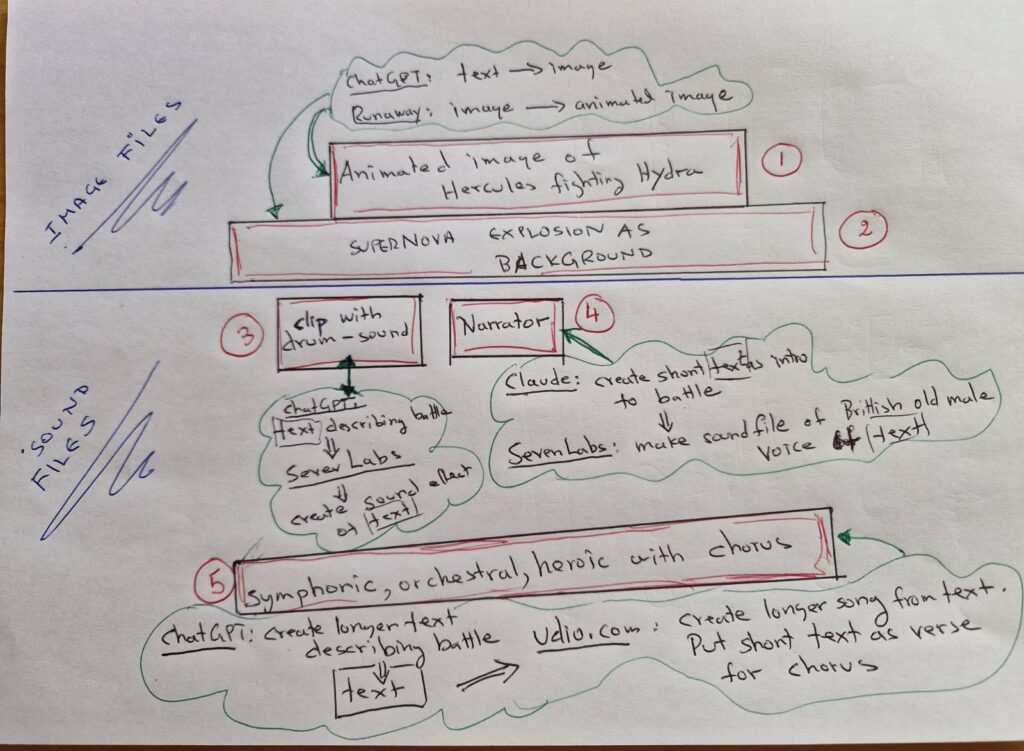AI animation in the first newbie state. An attempt to create a short story combining various tools and platforms. Maybe I should rather say it was made entirely by AI. I only gave an initial idea and coordinated the efforts.
*sound must be on*
UPDATE: This current AI animation attempt resulted in the following more completed video o the YouTube channel of the Greek Expedition:
AI Tools used in both films:
- ChatGPT: create describing texts, create images
- Claude: create describing texts,
- RunWay: animate images
- Udio: create music and songs
- ElevenLabs: create AI voices and sound effects
- StableDifussion: create images (software locally installed)
First attempt (experimental)
Elements of AI animation in first attempt
The AI animation film consists of five elements, two image files and three sound files:
Image files:
- Animated image of Hercules fighting Lernean Hydra
- An animated super-nova explosion as background
Audio files:
- Clip with drums
- Narrators voice
- Longer orchestral piece with chorus

*EDIT: the platform is named ElevenLabs
Analysis and explanation of flow chart
To create this film, I combined five key elements using various AI tools. The visual foundation consists of two image files: Hercules battling the Hydra and a background supernova explosion. I generated these images by prompting ChatGPT and then animating them using Runaway, layering Hercules over the cosmic backdrop.
The audio files
The audio landscape is composed of three distinct tracks. First, a rhythmic drum sound sets the tone for the battle. I crafted this by asking ChatGPT to describe the sonic atmosphere of Hercules’ clash with the Hydra, then converting the resulting text into sound effects using ElevenLabs.
Next, I introduced a narrator’s voice. For this, I prompted Claude AI to create a Homeric-inspired introduction to the battle. I then used ElevenLabs again to generate the narration, opting for a deep, British male voice that I’d previously employed in another project.
Battle of the Titans
The third audio element is an epic orchestral piece titled “Battle of the Titans.” This began as a detailed battle description from ChatGPT, which I refined and input into Udio.com. There, I crafted a symphonic, heroic composition complete with a chorus. Interestingly, the chorus echoes the narrator’s text, creating a powerful auditory synergy.
Put together in video-editor
With these five elements prepared, I assembled them in Final Cut Pro, though any video editing software would suffice for this straightforward compilation. I made minor adjustments to balance the audio and visuals, then added simple text for the introduction and conclusion.
The result is a completely AI-generated short film that brings the legendary battle between Hercules and the Hydra to life through a blend of visuals and sound. It showcases the potential of combining various AI tools to create engaging multimedia content.
If you have any questions about the process or the tools used, please don’t hesitate to reach out.
Analysis and explanation of flow chart in sound file:
For any questions or remarks, please contact me here>>
ChatGPT analysis of Flow chart of AI animation
The flow chart of animation AI is divided into two main sections: Image Files and Sound Files.
Image Files Section
- Animated Image of Hercules Fighting Hydra:
- ChatGPT: Generate text descriptions of the desired images.
- Runway: Convert these images into an animated format.
- Background: Supernova Explosion:
- This serves as the backdrop for the animated scene, enhancing the dramatic effect.
Sound Files Section
- Clip with Drum Sound:
- ChatGPT: Write text describing the battle scenes.
- Seven Labs: Create sound effects based on the textual descriptions.
- Narrator:
- Claude: Generate short texts introducing the battle scene.
- Seven Labs: Produce a sound file using the voice of an old British male, narrating the text.
- Symphonic, Orchestral, Heroic Music with Chorus:
- ChatGPT: Write a longer text describing the battle.
- Udio.com: Create a longer song from the text, using short texts as verses for the chorus.
Workflow Integration
The flow chart illustrates a sequential process where different AI tools and platforms are used collaboratively to produce a coherent and immersive animated film segment.
- Step 1: Starts with generating an animated image of Hercules fighting the Hydra using ChatGPT for textual input and Runway for animation.
- Step 2: Integrates a supernova explosion as the background to enhance the visual impact.
- Step 3: Focuses on sound creation, where drum sounds are added to the battle scenes based on ChatGPT’s descriptions, processed by Seven Labs.
- Step 4: Involves narration, where Claude writes introductory texts and Seven Labs produces a narrated sound file using an old British male voice.
- Step 5: Ends with the creation of a symphonic and heroic soundtrack with a chorus. ChatGPT writes an extended description of the battle, which Udio.com transforms into a full song, incorporating short texts as verses for the chorus.
This structured approach ensures that both visual and auditory elements are meticulously crafted and synchronized to create a compelling animation of Hercules fighting the Hydra, set against a dramatic supernova explosion backdrop.
The flow chart visually represents a collaborative and multi-step process leveraging various AI technologies to produce a sophisticated animated film segment, combining detailed visual animations with rich soundscapes and narrative elements.
